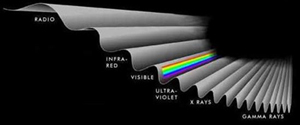Spectrometers are instruments that allow scientists to detect energy that would otherwise be invisible to human eyes and record data about it.
We call the part of the electromagnetic spectrum that we can see directly with our eyes "visible" or "optical" light. To fully appreciate the complexity of the world around us, however, we need to rely on human-made devices to provide views of the "invisible" world in the parts of the electromagnetic spectrum we cannot see without the aid of technology -- gamma rays, X-rays, ultraviolet waves, infrared waves, microwaves, and radio waves.
 There's light and then there's light. The difference between the kinds of electromagnetic energy is wavelength, which is the distance between the peaks in this NASA artwork.
There's light and then there's light. The difference between the kinds of electromagnetic energy is wavelength, which is the distance between the peaks in this NASA artwork.
All electromagnetic energy might be thought of as "light," even though our eyes only see part of the spectrum. Note the tiny area of color in this NASA artwork representing light visible to the human eye.
Notice that wavelengths get larger moving across the electromagnetic spectrum from gamma rays to radio waves. The wavelength of visible light is about 1/10th of a micrometer. The full electromagnetic spectrum includes both shorter and longer wavelengths.
Familiar ways of using invisible light with wavelengths greater than or less than the eye can see include medical x-rays and airplane radar.
Spectrometers sent to distant planets of the Solar System tell scientists a great deal about those planets' composition -- what they are made of -- and their radiation environments. That knowledge would not be possible if we had only our eyes.
 How spectrometers work. Spectrometers are instruments that spread light out into wavelengths called "spectra," which look something like rainbow-colored bars.
Using the spectra, scientists can look for and study the "emission lines" and "absorption lines" that are sort of fingerprints of atoms and molecules that may be present.
How spectrometers work. Spectrometers are instruments that spread light out into wavelengths called "spectra," which look something like rainbow-colored bars.
Using the spectra, scientists can look for and study the "emission lines" and "absorption lines" that are sort of fingerprints of atoms and molecules that may be present.
Each atom has a unique fingerprint because each can only emit or absorb certain wavelengths of energy. Thus, the fingerprint -- as seen in the location and spacing of spectral lines -- is unique for each atom. Spectrometers are the instruments that engineers build to detect the fingerprints.
Spectrometers in use. A current example of spectrometers in use can be found in the 2001 Odyssey spacecraft that NASA sent to Mars. The Odyssey orbiter makes use of three different kinds of spectrometers:
- THEMIS, the Thermal Emission Imaging System looking at Mars in the visible and infrared parts of the spectrum in order to determine the distribution of minerals on the surface of Mars
- GRS, the Gamma Ray Spectrometer looking at the gamma-ray part of the spectrum for the presence of 20 elements from the periodic table such as carbon, silicon, iron or magnesium.
- MARIE, the Mars Radiation Environment Experiment using an energetic particle spectrometer to measure the radiation environment of Mars.
Information and images source: NASA, Jet Propulsion Laboratory, California Institute of Technology